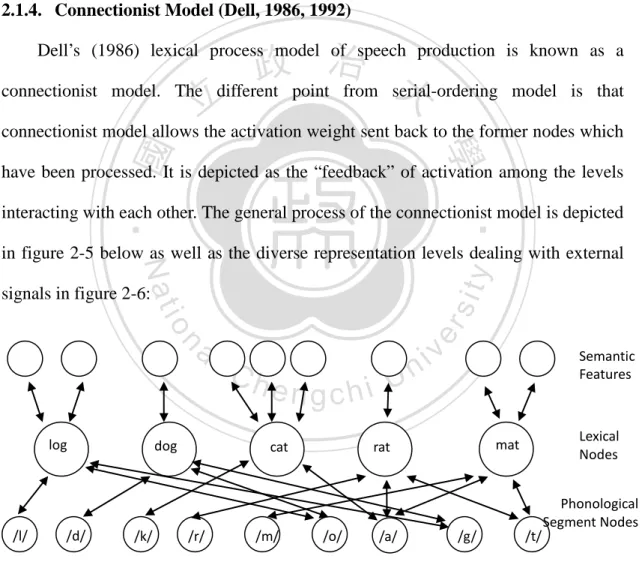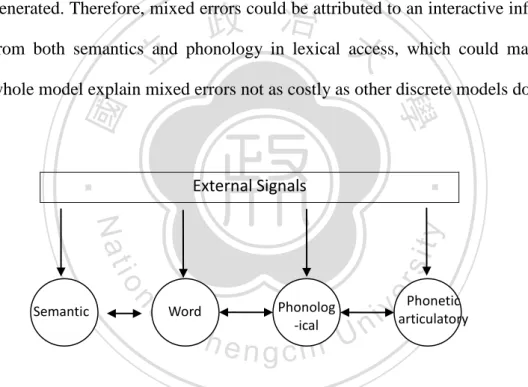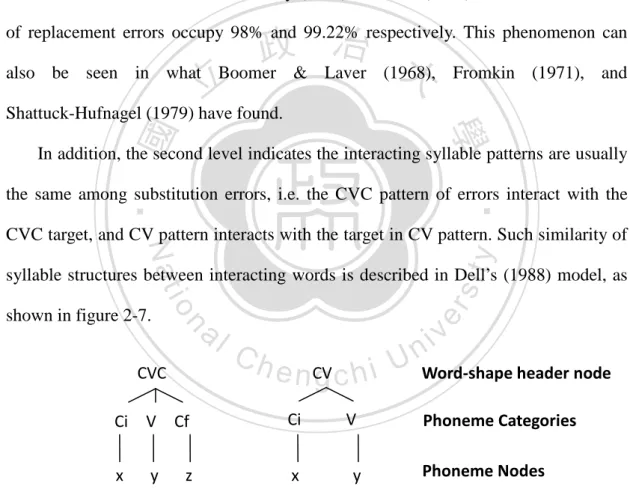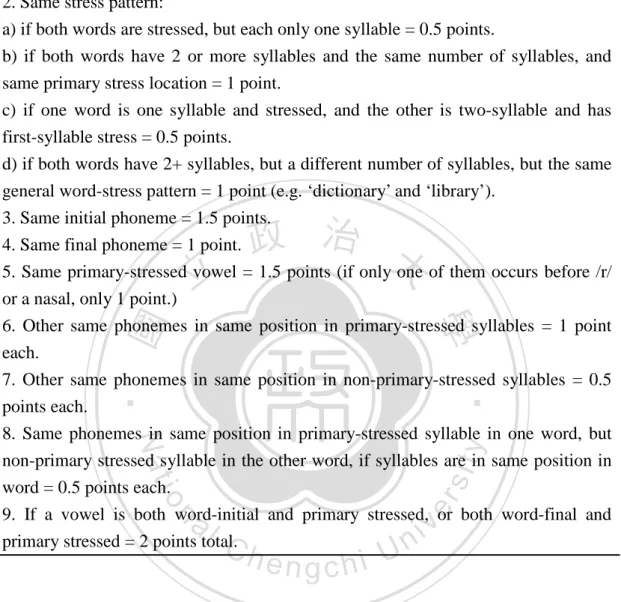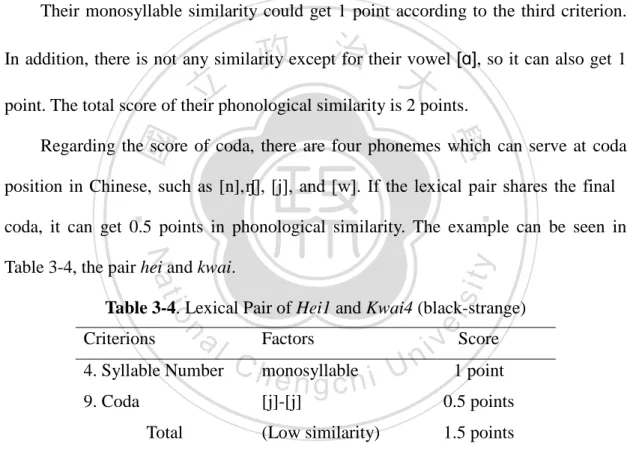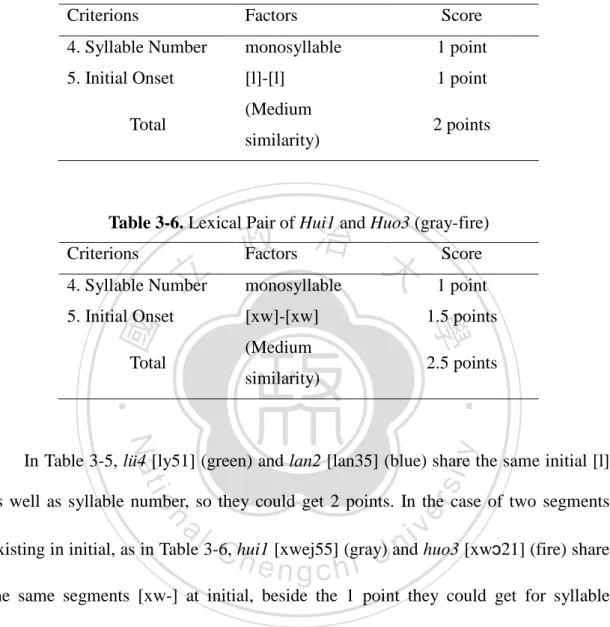中文顏色詞彙處理機制:心理語言學的實證 - 政大學術集成
全文
(2) The Lexical Process of Color Terms in Chinese: Evidence from Psycholinguistics. 學. ‧ 國. 立. 政 BY 治 大 Yu-tai Hsiao. ‧. n. er. io. sit. y. Nat. al. Ch. engchi. i n U. A Thesis Submitted to the Graduate Institute of Linguistics In Partial Fulfillment of the Requirements for the Degree of Master of Arts. July, 2011. v.
(3) 立. 政 治 大. ‧. ‧ 國. 學. n. er. io. sit. y. Nat. al. Ch. engchi. Copyright @ 2011 Yu-tai Hsiao All Rights Reserved. i n U. v.
(4) ACKNOWLEDGEMENTS 有言,有我 「語」,從言吾聲。細解其部,有言有我。 我不由得想起進入語言所的初衷。 將望遠鏡拉大至可以對焦過去 26 載的座標系,我發現自己的人生走向,是 從幼時在電視節目的字幕上看到了「難」這個字。當時年幼不解其意,僅覺這字 型真是詭異,小手在空中胡亂揮了一番,發現自己能看一眼便將這「難」字立就, 心裡異之,成就感驅使著這小小孩長大。. 政 治 大 可以化解身為書呆子的格格不入。亦師亦父的許長謨教授的語言學課程開始讓我 立 抱持著對數科的無力感、英文的使命感,進入了中文系,勉強欺騙自己文學. 正視「語言」這個議題,在潛意識中是多麼地被自己關注。導致我點起火種後,. ‧ 國. 學. 奮勇前往外文系再修了蔣炳榮老師語言學概論,以一種嚴肅的態度幫語言在自己. ‧. 青春中定義劑量。那時永遠不會曉得,蔣老師曾在成大教過一位以失語症專題在. io. er. 一職,此青年學人即我的指導教授萬依萍老師。. sit. y. Nat. 台灣一片語言學理論為宗的領域異軍突起的學生,後來在政大語言所擔任起所長. 緣份在舉起時難以言表的那一刻起,便以一種無法辨識的邏輯串聯起來。萬. al. n. v i n 依萍老師提供了實驗室、失語症及客語等專案計畫,讓我能在其麾下參與執行實 Ch engchi U 驗與台大醫院的語料採集,在計劃的參與中更接近我想要關注的議題,也讓這份 論文的付梓埋下了契機。 說錯話,是我此生最害怕的事情之一;但我卻藉著語誤研究去叩問我最好奇 的知識。 這份實驗性的語誤研究,在這條路上蒙受台灣許多學者的指教與垂顧,從 2010 年喜懷千金的指導老師催生下肇始,10 月在時任所長的黃瓊之教授與師大 徐東伯老師共同指點下通過論文計畫書,為本文奠定良好的架構;11 月至中央 研究院發表,接受語音學大師 Lieberman 教授及與會學者的評點;隔年 7 月在口 iv.
(5) 試委員徐東伯老師與政大林祐瑜老師的審查與口考下通過學位資格;復於同年 10 月在第十二屆 NCL 發表本篇論文相關成果,得以聆受同為研究 Connectionism 之成大心理系胡中帆教授的鼓勵與心理實驗設計上建議。 我覺得時間不夠用。就算時間以秒來計時,依舊不夠用來將此論文修得更臻 完善。特別是經常受我「剝削」的指導教授,卻從不吝給我全方面的照護。 修業期間,有一些老師的影響舉足輕重。 在語言所迴廊上靠著電動輪椅滾動起大家思緒的蕭宇超老師,讓我碩一時能 夠用自己的力量與夥伴赴泰國參加國際會議。每到心理的一個分岔口,都很痛苦,. 政 治 大 什麼風景。雖難於行,卻總是走得比我們想像中都長都遠。 立. 但是總在這危惴不安的時刻,能夠提供一頭栽下去的動力,看看那條路的盡頭是. 曾經立下志向,每學期至少要修一門何萬順老師的課,再難的行路,一定要. ‧ 國. 學. 修練下去。句法學家就像是在山洞點起一盞燭火守夜的人,得耐得住寂寞,搖椅. ‧. 是唯一的娛樂,靈光乍現的當下,即便因驚訝而熄滅了滿室的光火,也在所不惜。. y. Nat. 總是為了領受這靈光乍現的感動而於洞口外積極回應。. er. io. sit. 更是無法忘懷詹惠珍老師在聽聞口試過關的當下,在停車場為我仰天長嘯的 那一幕。若非詹老師的課,則無法牽起南島語和共處在同一座小島上的我之間的. n. al. 羈絆。. Ch. engchi. i n U. v. 惠鈴助教關鍵時刻的擁抱,將我把傾斜的地標扶正;如炬般的目光關候著所 上每個人兒的一顰一痛,彷彿身上任何一處的抽搐,都能讓你共感。因此看到你 而能放心,蹲下拾起散落四處的行囊,繼續走下去。 博士班是一群深藏不露的學長姐匯萃之處,在朝來水溶溶的市集中裝成路人 四處遊走,偶爾揭穿某個人的身分,便會迅速變出一朵炫目的筋斗雲,在嘖嘖稱 奇的一刻笑著乘著離去。在口試的這一天,彷彿說好似的,不經意地出現在我必 經的路上,慷慨的提供微笑和心靈力量,還有無私的信任。文山秋天的山林像一 首詩,送著章和的楓香和泠泠的雨聲。 v.
(6) 每天一大清早,在不覺晨昏的實驗室,進行無數個行政事務還有語誤誘發的 實驗。電腦桌面總是開滿著大大小小的視窗,新的銀幕巴不得愈換愈大,一個人 在比我房間寬敞的小小幽室中,於器官模型的注視下,臨著語音器材,埋首諸多 文案與音檔之間。經常會有許多天使如佳珈、晉瑋和涵絜、亭伊在實驗室的各個 角落相伴,關心著你的近況、關心著怎麼完成老師交派的任務、關心著近來的梗 概和彼此的小未來。實驗室的窗外是一座供鳥禽和人遊憩的庭院,矗立著幾株蓊 鬱的闊葉樹,偶爾開出幾朵美麗的花,謙虛的等人尋覓喑啞的鳥囀而發現。 人身上都有超乎尋常的能力,這個超能力的行使是自己無法意識、但他人能. 政 治 大 心相近的宏瑋用上帝滿滿的愛提醒我早已被神認識、並關愛著,所以我的身邊有 立. 輕易感受的能量,讓疲弱之人得到支持。在梵文中,此為「加持」之意。身雖離. 采君、孟英、怡璇、佩如這些好朋友不定期定量的投以關愛,在一個讓我很舒適. ‧ 國. 學. 的距離輕輕拍落肩上的塵埃,常常讓你們忍受我偽善的世故,但台北因有你們而. ‧. 有溫度。還有經常床邊閒談鴻志的室友孝從,相見亦無事的語言 97 人,不來常. y. Nat. 思君的中文 96 人,以及一同在師大林千哲老師的心理語言學相見恨晚的 Julia、. er. io. sit. Brandon 與 Grace。木柵的潮濕常常鏽蝕著如碳鋼般的意志,在這只有燭光的山 洞裡,享受大夥身上各自帶著一點鏽蝕的傷痕幫彼此除去溼氣。. al. n. v i n 對雙子座的人來說,生活是一幅多邊形,擁有許多稜角,角度寬狹不一,但 Ch engchi U. 必能找到質量重心,平衡各個層面,並用一條線穿引懸掛於風中。婷婷老師用舞 蹈訓練著我的平衡感,在平時說話慣了、研究慣了語言之外,教我用肢體說話。 我們在教育及舞蹈這兩條平行線上相知相惜,與這群一同在救國團學舞的姐姐們、 年輕一輩的小弟小妹們,燃燒著不知已過了幾載的青春。 對我來說,有一處最重要的碼頭名為葉赫,它是我身為人師的啟蒙地,若在 我拋下船錨的當下,有個人會幫我用愛心與耐心、把繩索緊緊繫在碼頭邊的,那 個人就是葉玉堂老師。念當初為了讓教學能更符合語言的真相與脈絡進入了語言 所,他用一通電話提供了舞台讓我能實踐語言學中的種種思維,使學生以一種有 vi.
(7) 「理」可說的方式認識語言、學習語言。方寸大的教室,坐滿著一欠身就能挑起 一袋米、跟你談經論道、逼急了瞳仁會流出怯怯神情的國中生,我們各自參與著 追逐對方漸去漸遠的背影,告訴彼此:不必追!龍應台眼中的目送大概就是這種 感覺了吧。 不知在多少萬籟俱靜的夜晚啃資料、撰寫,母親用堅定且擔心的口吻說: 「好 去睡了。」我總是用石頭般的冷漠回應。我以為只有母親可以了解我淡定之下塵 土盡揚的雜緒,唯她能善解。睡不到五小時,一大清早坐著老爸的便車、或他作 我的乘客前往木柵。每天短短二十分鐘的相處,從原本的不耐…漸漸了解他的一. 政 治 大 心的自律與自強回報。甫出嫁的姊姊用她的方式一直關心著我這個做弟弟的;還 立. 生。二位長久以來用青春為土、愛心為料的栽培與犧牲,只能以盡量不讓你們操. 有自胚胎時期比鄰而生的雙胞胎哥哥,這份論文的統計概念多虧有他提點,雖不. ‧ 國. 學. 至完善,但比起自個兒橫衝直撞到某個死胡同而不自知要好太多。一家人在一起,. ‧. 小時會貪婪的希望大家將時間停留在自己身上,我們渴望相愛、專情;等年事稍. y. Nat. 大,會希望時間加快些,開始擔心自己之於對方是否只是一廂情願;到了接近出. er. io. sit. 社會的那一刻,會希望時間走得慢一些,把青春期邁出父母太多的步伐放輕放慢 點,看清你們臉上歲月爬梳過的容貌。 對你們這一段情感真的很難寫盡,一直. al. n. v i n 有股力量阻止我繼續延展下去,暫且用這一本論文表達對你們的感謝。 Ch engchi U. 這本論文且戰且走,過了好長一段時間才勉強付梓。等待的過程很沉重,但. 這個重量卻將我自己愈貼近知識、愈貼近生命。在啟程前往菲律賓前夕,為輕如 鴻毛的青春,留下一些痕跡。 這本論文沒有很偉大,但它很像我會做的事。. vii.
(8) VITA. Education 2012/03. M.A. in Institute of Linguistics, National Chengchi University. 2008/06. B.A. in Department of Chinese Literature, National. 政 治 大. Cheng Kung University. 立. ‧ 國. 學. Grants and Scholarships Graduate Student Scholarship National Chengchi University. n. al. er. io. sit. y. Nat. 2011. ‧. 2009-2010. The Phi Tau Phi Scholastic Honor Society of The. Ch. Republic of China. engchi. i n U. v. Publication 2011. "The Phonological Effect on Lexical Encoding in Chinese: Evidence from Stroop's Technique and Speech Error" 12th National Conference of Linguistics: Kaohsiung.. 2010. “The Lexical Process of Color Terms in Chinese: Evidence from Psycholinguistics.” Seminar on Phonetics/ Phonology and the Evolution of Language, Institute of Linguistics, Academia Sinica: Taipei. viii.
(9) “ A Phonological Analysis of Disyllabic Mandarin. 2009. Onomatopoeia.” , with W.-C. Yep, M.-T., Chang, 42th International Conference on Sino-Tibetan Language and Linguistics, Payap University: Thai.. 立. 政 治 大. ‧. ‧ 國. 學. n. er. io. sit. y. Nat. al. Ch. engchi. ix. i n U. v.
(10) TABLE OF CONTENTS. Acknowledges………………………………………………………………………….....iv VITA…………………………………………………………………………………….viii Table of Contents …………………………………………………………………………x List of Tables …………………………………………………………………………….xii List of Figures …………………………………………………………………………..xiv Chinese Abstract ………………………………………………………………………....xv. 治 政 INTRODUCTION ……………………………………………………….1 大 立 LITERATURE REVIEW………………………………………………5. English Abstract ……………………………………………………………………….. xvi CHAPTER 1. 學. ‧ 國. CHAPTER 2. 2.1. Models of Speech Production …………………………………………………..5. 2.1.1. Utterance Generator Model of Speech Production …………………..5. ‧. 2.1.2. Levelt’s Lexical Model ………………………………………………….9. y. Nat. 2.1.3. Interactive Activation Model …………………………………………..11. sit. 2.1.4. Connectionist Model……………………………………………………14. er. io. 2.2. Linguistic Effects in previous studies …………………………………………17. al. v i n Ch 2.2.2. Rhyme Effect …………………………………………………………..18 engchi U n. 2.2.1. Initialness Effect………………………………………………………..17. 2.2.3. Phonological Similarity Effect…………………………………………19. 2.2.4. Syllable Structure Effect ……………………………………………….20 2.2.5. Tone Effect …………………………………………………………….21 2.2.6. Phonotactic Regularity Effect…………………………………………..22 2.2.7. Stroop Effect …………………………………………………………...23 2.3. The Planning Unit in Sound Production……………………………………….24 2.4. Literature Summary and Research Hypothesis ………………………………..25 CHAPTER 3 METHODOLOGY………………………………………………………28 3.1. General Methods of Task 1 ~ 4 ………………………………………………..29 3.1.1. Subjects ………………………………………………………………...29 x.
(11) 3.1.2. Colors and Phonological Similarity ……………………………………31 3.1.3. Test Items ……………………………………………………………...44 3.1.3.1. Task 1: Color Naming Test……………………………………..45 3.1.3.2. Task 2: Color Reading Test……………………………………..47 3.1.3.3. Task 3: Stroop Naming Test…………………………………….48 3.1.3.4. Task 4: Homophonous Naming Task …………………………..50 3.1.4. General Procedure and Data Analysis for Task 1 ~ 4 …………………53 3.2. Task 5: Shared Units Naming Task …………………………………………...55 3.2.1. Shared Unit: Onset …………………………………………………….55 3.2.2. Shared Unit: Vowel ………………………………………………….58 3.2.3. Shared Unit: Rhyme …………………………………………………...60. 政 治 大. 3.2.4. Shared Unit: Bare Syllable …………………………………………….62. 立. 3.2.5. Shared Unit: Bare Tone. ……………………………………………...64. ‧ 國. …………………………………………67. 學. 3.2.6. Shared Unit: Tonal Syllable. 3.2.7. General Procedure of Shared Unit Naming Task ……………………...69 RESULTS AND DISCUSSIONS……………………………………...71. ‧. CHAPTER 4. 4.1. The Structure of Speech error and Reaction Time: Task 1 ~ 4 ………………..71. sit. y. Nat. 4.2. Phonological Effect on Lexical Encoding …………………………………….83 4.2.1 Within Task……………………………………………………………..83. er. io. 4.2.2 Between Tasks…………………………………………………………..84. al. n. v i n 4.3. Linguistic Effects and Speech C h Errors: Test1 ~ 4U………………………………88 engchi 4.3.1. Initialness Effect ……………………………………………………….91 4.2.3 Generation of Speech Errors and RT in Stroop’s Tasks………………...87. 4.3.2. Rhyme Effect ……………………………………………………….….92 4.3.3. Tone Effect …………………………………………………………….93 4.3.4. Syllable Structure Effect ……………………………………………….94 4.3.5. Phonotactic Regularity Effect ………………………………………….96 4.3.6. Stroop Effect …………………………………………………………...96 4.4. The Structure of Speech error and Reaction Time: Task 5 ……………………98 4.5. Summary: Reflections on Lexical Process Models …………………………..105 CHAPTER 5 CONCLUSION ………………………………………………………..108 References………………………………………………………………………………110 Appendix 1: Stimuli Design…………………………………………………………….117 Appendix 2: Overview of Results………………………………………………………123 xi.
(12) LIST OF TABLES. Table 3-1: Jaeger’s Phonological Similarity Grading ………………………………32 Table 3-2: The Revised Criterions on Sound Similarity in Chinese…………………33 Table 3-3. Lexical Pair of Huang2 and Gao1………………………………………..35. 政 治 大. Table 3-4: Lexical Pair of Hei1 and Kwai4 ………………………………………….35. 立. Table 3-5: Lexical Pair of Lü4 and Lan2………………………………………….….37. ‧ 國. 學. Table 3-6: Lexical Pair of Hui1 and Huo3 …………………………………………..37 Table 3-7: Lexical Pair of zi3 and zhi1……………………………………………….38. ‧. Table 3-8: Lexical Pair of bai2 and hai3 …………………………………………….38. Nat. sit. y. Table 3-9: Lexical Pair of lan2 and u2……………………………………………….39. n. al. er. io. Table 3-10: Lexical Pair of huang2 and huei1……………………………………….40. i n U. v. Table 3-11: Homophonous Pair of [ly51] ……………………………………………41. Ch. engchi. Table 3-12: Homophonous Pair of lan2 and lan3 …………………………………...41 Table 3-13: Phonological Relations of Color Pairs ………………………………….42 Table 3-14. Lexical Pair of hong2 and huang2 ……………………………………...43 Table 3-15: Word Frequency of Color Terms and Corresponding Homophones ……51 Table 3-16: The Frequency Correlation between Color and Homophone …………..52 Table 3-17: Word list of onset sharing ………………………………………………56 Table 3-18: Word list of vowel sharing ……………………………………………..58 Table 3-19: Wordlist of rhyme sharing ……………………………………………...61 Table 3-20: Wordlist of sharing bare syllable ……………………………………….63 xii.
(13) Table 3-21: Wordlist of sharing tone ………………………………………………..65 Table 3-22: Wordlist of sharing tonal syllable ………………………………………68 Table 4-1: The Structure of Speech Errors ………………………………………….72 Table 4-2: Homogeneity of Proportions Among Subjects in Each Test……………...75 Table 4-3: One-Way ANOVA for Phonological Similarity and Trial Frequency…….76 Table 4-4: Post-hoc Analysis for Table 4-3 ………………………………………….77 Table 4-5: One-Way ANOVA for Phonological Similarity and Error Number ……...78 Table 4-6: Post-hoc Analysis for Table 4-5 ………………………………………….79. 政 治 大 Table 4-8: One-Way ANOVA for Phonological Similarity and RT in Tests ……...…81 立 Table 4-7: Homogeneity of RTs Among Subjects in Each Test ……………………..80. Table 4-9: Post-hoc Analysis for Table 4-8 ………………………………………….82. ‧ 國. 學. Table 4-10: The Counts of Linguistic Effects among All Errors …………………….89. ‧. Table 4-11: One-way ANOVA Results of Speech Errors ……………………………90. sit. y. Nat. Table 4-12: Post-hoc Analysis for Table 4-11………………………………………..90. io. er. Table 4-13: Summary of Linguistic Effects …………………………………………98 Table 4-14: The Structure of RT and Errors N in Test 5 …………………………….99. al. n. v i n C hError Counts Among Table 4-15: One-way ANOVA for Target Units ……………100 engchi U Table 4-16: Post-hoc Analysis for table 4-15 ………………………………………100. Table 4-17: One-way ANOVA for RTs Among Target Units ………………………101 Table 4-18: Post-hoc Analysis for table 4-17 ……………………………………....102 Table 4-19: Summary of Phonological Units ………………………………………105. xiii.
(14) LIST OF FIGURES. Figure 1-1: Color Taxonology in English ………………………………….………….2 Figure 2-1: Fromkin’s Utterance Generator ………………………………………..…6 Figure 2-2: A blueprint for the speaker ……………………………………………….9. 政 治 大. Figure 2-3: Example of activation-spreading network ………………………………10. 立. Figure 2-4: Interactive Activation Model ……………………………………………12. ‧ 國. 學. Figure 2-5: Lexical network in the spreading activation production model ………...14 Figure 2-6: A simplified network in which external signals are received ………...…16. ‧. Figure 2-7: Syllable Constituent and Structural Hierarchy ………………………….20. Nat. sit. y. Figure 4-1: Simulated lexical network for Stroop technique ………………………..86. n. al. er. io. Figure 4-2: Response Time and Speech Error in Experiment 3 ……………………99. Ch. engchi. xiv. i n U. v.
(15) 國. 立. 政. 治. 大. 學. 研. 究. 所. 碩. 士. 論. 文. 提. 要. 研究所別:語言學研究所 論文名稱:中文顏色詞彙處理機制:心理語言學的實證 指導教授:萬依萍 博士 研 究 生:蕭裕台 論文提要內容:(共一冊,字,分五章,並扼要說明內容,共 741 字) 長久以來,序列式詞彙處理模式以及互動式詞彙處理模式經常爭論孰為合理 的語誤生成模型。這份研究企圖利用心理學實證角度探究此議題。原屬於心理學 範疇的史楚普技術(1935)或可提供語言學多方面的視角,尤其在我們處理顏色詞. 政 治 大. 彙時詞彙譯碼歷程上與視覺表徵之間的關係。因此我們試圖將此經典心理學技術. 立. 轉化成宜於語言學研究的語誤誘發實驗。藉由控制變項間的語音近似度,創制了. ‧ 國. 學. 四項實驗,分別是:顏色唸名實驗、顏色誦讀實驗、史楚普唸名實驗、同音詞唸 名實驗。結果顯示,即便受試者對語音近似度並未在單項實驗中產生語誤數量與 反應時間的差異,但它在不同實驗任務之間卻誘使受試者產生不一樣的反應結果,. ‧. 包括數量上及時間上的顯著差異。. y. Nat. 此外,我們針對語誤,分析其與目標字之間的關係,研判部分音韻效應是否. io. sit. 對詞彙處理網絡造成顯著影響。結果顯示,史楚普效應、音韻結構、音法限制以. er. 及聲調效應在語誤數量中均出現顯著的生成量;音節首、韻部以及母音則並未出. al. n. v i n Ch 也讓我們看到音韻效應在不同視覺任務指派中產生顯著差異的結果。如此看來, engchi U. 現顯著效應。史楚普技術除了在語誤證據中為文字閱讀提供自動化效應的解釋外, 互動式模型提供了較為簡潔的解釋。來自二元視覺刺激(視覺色彩與顏色詞)的詞 彙競爭,該框架可以合理提供理論基礎,並解釋不同視覺任務之間音韻關係依存 度的不同。 另一方面,我們亦援引同樣技術設計出以音韻單位為導向的唸名實驗,討論 語言輸出前規劃單位之議題。我們發現,僅含聲調的音節以及無聲調的音節可在 詞彙網絡中做為語言規劃之心理處理單位,促進詞彙處理效能。其他單位如音節 首、介音、母音、韻尾、聲調則無法出現顯著效應。同時亦於實驗中發現,中文 聲調於規劃階段時,應是屬於詞彙結構上的聲調,而非純粹的聲韻調。. 關鍵字:詞彙處理模型、史楚普效應、音韻近似度、語誤、語言規劃單位 xv.
(16) Abstract Serial-ordering model and interactive processing model have long been discussed as whether people process languages in a sequential level of processing or the consequence of levels interacting altogether by looking at speech errors. Stroop technique (1935) in psychology could give linguistics some insights on the relation between lexical encoding and visual representation when people process colors. We tried to adapt this classical psychological experiment for an experiment of speech error elicitation. By means of controlling the phonological similarity, we created four experiments: color naming, color reading, Stroop naming, and homophonous naming tasks. The result first showed that even though phonological similarity did not induce. 政 治 大 caused significant difference 立in these results among these tasks.. significant difference in error amount and response time within single task, it still. ‧ 國. 學. Second, after analyzing the linguistic relation between targets and speech errors, we found that Stroop effect, syllable structure, phonotactic regularity, and tone. ‧. induced apparent effects in error generation, while initial, rhyme, and vowel did not. Stroop effect not only provided the evidence from speech errors where character. Nat. sit. y. representation was an autonomous mechanism in lexical process, but also provided a. io. al. er. fact that phonological effect would impacted differently on amount of error according. n. to the type of visual task. It seems that interactive account could help explain the. Ch. i n U. v. result easily, as the competition from dual visual inputs could be given a theoretical. engchi. basis to account for the phonological dependency according to certain visual task which subjects were assigned to. Finally, we also discussed the issue of advanced planning unit in lexical process. In the shared unit task with Stroop technique, we found that only the units of tonal syllable and bare syllable could serve as possible planning units in lexical network, and tone in Chinese should be attributed to a type of lexical tone in planning, rather than a pure phonological tone. To sum up, the purpose of the study attempts to provide empirical evidence to examine the above issues. Key words: Lexical model, Stroop effect, phonological similarity, speech errors, advanced planning unit xvi.
(17) Chapter 1 Introduction The operation of language is the composition of lexicons and mental rules constructed in mind. The way in which the basic units are constructed could reflect the structure of an utterance, even though it is a process of interaction from several linguistic components: syntactic, semantic, and phonological layers etc. These layers could be attributed to human’s linguistic competence that conveys the information to listeners and to process the linguistic signal from context. In such a language system, it doesn’t always lead to a perfect and well-constructed linguistic form in daily language use.. 立. 政 治 大. With the evidence of speech error, the inconsistence between linguistic. ‧ 國. 學. competence and language performance exists. Speech error has been an important source to study the linguistic mechanism and organization of cognitive ability in. ‧. linguistics and psycholinguistics because any tiny problem (or noise), which happens. y. Nat. sit. to the process of language, will result in slips of tongue (Stemberger, 1984; Martin et. n. al. er. io. al., 1996). Speech errors always reflect the failure or malfunction of their. i n U. v. corresponding mechanism and linguistic structure (Fromkin, 1973; Shattuck-Hufnagel, 1979).. Ch. engchi. In addition to errors in naturalistic settings, psycholinguistic experiments have been conducted to induce observable speech errors and apply the data to simulate the processing model (McClelland & Rumelhart, 1981; Dell & O’Seaghdha, 1992; Sevald et al., 1995; Dell & Juliano, 1996; Roelofs, 1996; Dell et al., 1997; Levelt et al., 1999; Dell et al., 2004; Martin et al., 2004). On the other hand, several linguists took the corpus of speech errors to elaborate the linguistic structure and visualize model of speech production (Fromkin, 1973; Shattuck-Hufnagel, 1979; Garrett, 1980 & 1988; Dell & Reich, 1981; Stemberger, 1985; Martin et al., 1996; Levelt et al., 1999; Wan, 1.
(18) 1999 & 2007). As a representative of serial model, Garrett (1980) proposed that the linguistic levels should be independent, and linguistic signals are processed step by step. However, as to an interactive view of language mechanism, not only Dell and Reich (1981) had observed the phonological similarities in word substitution, but Stemberger (1985) assumed these layers should be interactive when accessing lexicon, and the feedback from the form (phonological) representation could cause the wrong activation back to the lemma level to retrieve the wrong lexicon which is not intended. Sometimes, speech error might come from more than one layer because of shared target words and error words, such as 政 治 大 phonological-semantic error. The two main models of language process, serial and 立 linguistic. information. between. interactive models, always adopt speech errors elicited from experiment or corpus. ‧ 國. 學. observation to help them simulate and infer the possible route and operation of lexical. ‧. process.. sit. y. Nat. In this study, color will be the main focus of lexical process when we deal with. io. er. the issue on lexical process. The semantic term ‘color’ will be specified throughout the study. Color is a universal concept, which maps to a language-specific lexical term. al. n. v i n according to languages. Color C refers to a taxonomicUrelation in semantic field. For hengchi. example, as shown in figure 1-1:. Color Red Crimson. Orange. Yellow. Green. Pink. Cyan. Blue Royalblue. Purple Navy. Indigo. Figure 1-1. Color Taxonomy in English. In figure 1-1, the semantic hierarchy tells that the colors can be subcategorized 2.
(19) into detailed ones, as crimson and pink of red, indigo of purple. Apparently, in the semantic field, these color terms are structured in a family which is superordinated by a general concept: color. With the view of semantic network, the hyponyms, dominated by “color,” are connected tightly. In this study, we would like to adopt color to test whether the naming or reading tasks would produce speech errors inside or outside of the semantic field, and whether phonological similarity would induce speech errors during lexical processing. With regard to human’s visual competence, Stroop’s technique (1935) could be a classical experiment to study the speed of. 政 治 大 semantic concept through visual channel. If we create the inconsistence between the 立. naming and reading. Besides the terms, the ink color of the term can also convey a. color term and the visual color of carrier, the competition of the semantic and. ‧ 國. 學. phonological information would induce some kind of “noises” during the lexical. ‧. activation. The chance of speech error, or we can say the output through incorrect. sit. y. Nat. activation, might get increased in speaking. Stroop (1935) conducted a series of. io. er. psychological experiments to test the reaction times among the color naming task, color term reading task, and the task of naming the visual word with different colors.. al. n. v i n C hfor naming wouldUbe increased and prolonged by It suggested that the reaction time engchi the presence of conflicting visual concepts, word and color at the same time. He found. that the interference effect occurred when human processed the linguistic unit with visual, physical or linguistic conflict at the same time, which is well-known as Stroop effect. In this study, we would like to conduct a series of experiments to extend Stroop’s work. We adapted the classical experiment for an ideal one for Chinese, and we observed and analyzed the speech errors by means of controlling phonological similarity. We hope to understand the status of phonological similarity in lexical process. There were five experiments: color naming test, color reading test, Stroop 3.
(20) naming test, homophonous naming test, and shared unit test in this study. The organization of this study includes: literature review will be introduced in chapter two, focusing on the mechanism of naming and reading tasks, production models, planning unit and linguistic effects. The proposals will also be outlined in the same chapter. Chapter three will elaborate the stimuli organization and procedural design for each experiment, including the color naming and reading task with or without color competition. Chapter four will present the data on reaction time among experiments and speech error analysis so far. In this study, we try to figure out:. 政 治 大 with their targets and discuss linguistic effects between target and errors. Based on the 立 through the induced speech errors, we would like to analyze the phonological relation. amount of each error type and the reaction time, we would like to compare which. ‧ 國. 學. lexical processing model might be more appropriate to simulate the process of lexical. ‧. activation in Chinese which has been proposed by many psycholinguists.. n. er. io. sit. y. Nat. al. Ch. engchi. 4. i n U. v.
(21) Chapter 2 Literature Review Speech errors and response span will be mainly concerned in this study. The lexical process models will be reviewed in the first section. We will examine whether the structure of speech error and speed of lexical process would induce linguistic effects, which will be reviewed in section 2. Besides, the issue on advanced planning units in language production will be reviewed in section 3. The interaction between sound activation and lexicon receiving, linguistic effects and the advanced planning. 政 治 大. units will be the main issues of processing model in this study.. 立. 2.1 Models of Speech Production. ‧ 國. 學. Lexical access models have been used to explain mechanism in lexicon storage. ‧. when we process language. There are two main debates on how cognition system. sit. y. Nat. processes the lexicon information: serial-ordering model and parallel interaction. io. er. model. The diverse routes in lexicon processing induce dissimilar patterns of sound and meaning process when perceiving as well as encoding lexicon. However, the. al. n. v i n Cshould assumption in any of the models the sub-goal—simplicity for cognition U h e nattain i h gc process.. In this study, we also put focus on the interaction between sound activation and the lexicon retrieving. The selection of semantic concepts and phonological information will be mainly concerned in the following section. In addition, the goal of this research is to compare the serial model to the interactive model, and testify which side could have proper explanation on the lexical production.. 2.1.1 Utterance Generator Model of Speech Production Fromkin (1971) attempted to account for various types of speech error, and the 5.
(22) Utterance Generator Model was presented in a top-down manner without any feedback loops in language processing. Fromkin (1986) proposed that speech error could give more insights on the organization and representation of lexical items. The Utterance Generator model (Fromkin, 1971) is presented in Figure 2-1:. 立. 政 治 大. ‧. ‧ 國. 學. n. er. io. sit. y. Nat. al. Ch. engchi. i n U. v. Figure 2-1. Fromkin’s Utterance Generator (from Fromkin, 1971). In Fromkin’s model, the process of lexicon is divided into five stages: syntactic structure, semantic features, phrasal and prosodic assignment, phonological rules, and motor command. In Figure 2-1, the rectangular boxes in the diagram stand for the linguistic representations at each level; the diamonds symbolize the processes that 6.
(23) translate each level of representations into the following one. The stages, representations, and processes are outlined below: Stage I. A meaning to be conveyed is generated. Fromkin assumed the model could allow the generation of more than one message at stage one. Fromkin quoted Butterworth (1980) and supposed that an adequate model of speech production should account for “competing plans” at all levels. This leads to one kind of speech errors at this stage—syntactic blending, such as How long does that has to…have to simmer. This model. 政 治 大 Stage II. The message is mapped onto a syntactic structure. 立 allows multi-representations at any processing levels.. After the semantic features and organization are outlined at first stage, a. ‧ 國. 學. syntactic framework of the message is created, and semantic information will be. ‧. mapped onto these grammatical structures. At this stage, a semantic-syntactic. sit. y. Nat. structure is marked as lexical nodes in the phrase marker for selecting words or. io. syntactic structure will be specified at this stage.. n. al. Ch. Stage III. Intonation contours are generated representations.. engchi. er. morphemes from the lexicon at next stage. The grammatical category and. ni onU the. v. basis of the syntactic. Fromkin supposed sentence and phrasal stress must be assigned before lexical selection occurs. Syntactic structure always determined the primary stress and intonation contours, and Fromkin assumed this prosodic assignment should be independent of any other level. Stage IV. Words are selected from lexicon. Now the message is represented as a syntactic structure, with semantic, syntactic features, and prosodic information well-specified. The lexical items are not fully specified. It means that the affixes are not spelled out phonologically, 7.
(24) and the stems are just at a stage of phonological features being specified as well as the syllable positions serially arranged. At this lexicon stage, semantically or phonologically similar words might be selected instead of the intended word. Fromkin also pointed out that mapping these words onto the grammatical structure may cause phonological segments or features to be dislodged out of their original sequence. Stage V. Phonological specification After the selection of lexical entries, the phonetic segments are fully. 政 治 大 Stage VI. Generation of the motor commands for speech 立. specified in the specified forms and the phonological rules operate at this stage.. At the last stage, the phonetic features bundles of segments or full syllables. ‧ 國. 學. are encoded onto motor system for the following series of articulation.. ‧. sit. y. Nat. This model advocates that the unit which induces speech error can be a segment. io. er. or a feature when mistakes happen at later stage (stage IV and V). Error occurring implies the malfunction in one of the linguistic operators. However, Fromkin &. al. n. v i n Ratner (1998) commented thatC this model did not provide h e n g c h i U enough details why the major categories (nouns, verbs, adjectives) seldom shifted or altered in speech error,. while functional categories and inflectional morphemes are. In addition, as Butterworth (1982) pointed out, if the model allows more than one sentences to be generated at initial stage, we might need more postulation of mechanisms (or rules) to generate the numerous proliferation of representations at the following levels. These postulations might make this generator model “more expensive” in explaining the speech generation.. 8.
(25) 2.1.2 Levelt’s Lexical Model (1989, 1999) As to the model of serial access, Levelt’s model is also a unidirectional operation in language processing, as shown in figure 2-2.. CONCEPTUALIZER message generation. Discourse model Situation knowledge Encyclopedia etc.. monitoring. parsed. preverbal message. 政 治 大 speech. FORMULATOR. 立. LEXICON lemmas. surface structure. 學. ‧ 國. grammatical encoding. SPEECH COMPREHENSION SYSTEM. Forms/ lexeme. ‧ y. Nat. phonological encoding. Overt Speech. n. al. Ch. er. io. ARTICULATOR. sit. phonetic plan. n U engchi. iv. Phonetic string. AUDITION. Figure 2-2. A blueprint for the speaker. (Levelt, 1989). Levelt proposed that from the concept formatted to the sound activation, the word activation is step-by-step at each procedure in a rapid manner. Two levels are distinguished during the orderly processing: lemma level and lexeme (form) level, which. are. both. linguistic. functions. in. formulator.. The. former. is. a. semantic-grammatical encoder, where concepts are passed on and assign proper grammatical function to each concept; the lexeme level refers to a phase which takes syntactic framework to generate phonological units (syllable and segment). Levelt believed that the two encoders are stored and operated separately. Once a category is 9.
(26) selected, the grammatical encoder (lemma level) would produce appropriately ordered sequence for lemmas.. 立. 政 治 大. ‧ 國. 學. Figure 2-3. Example of activation-spreading network. (Levelt, 1989) Figure 2-3 appears the phonological-segment access in detail. The phonological. ‧. encoder (lexeme level) then adopts the grammatical outline that is specified at lemma. y. Nat. sit. phase and generates the phonological plan for the utterance. The lemma information. n. al. er. io. is retrieved before lexemic information. The outline of these levels in Figure 2-2 listed below:. Ch. engchi. Phase I. The Lexical Level (or Concept Level). i n U. v. The image activates the lexicon module carrying all the information the brain has stored about “construct.” Each node is distributed in the network of connected neurons in brain. Adjacent lexical nodes exists semantic relations are also activated. Phase II. The Lemma Level (or Category Level) The activated concepts are passed on to this level, where the syntactic information is well assigned to each lemma. The grammatical features include the word order, case marking, thematic structure, and so forth, which are 10.
(27) specified at this level. Lemma is semantic-syntactically specified without segments filled in the position. If there are more than one activated nodes, usually the highly activated node wins. But the more competing concepts interfere, and the longer it takes to generate the intended lexicon. Phase III. The Lexeme Level (or Form Level) After the intended concepts are syntactically specified at the lemma level, all the phonological information starts to be specified and accomplished at this level. Tip-of-the-tongue always occurs at this level, when a given lemma was. 政 治 大. not sufficiently activated to have completed phonological encoding at lexeme level.. 立. With above “blueprint” of speech, Levelt further explained that self-monitoring. ‧ 國. 學. effect operates and helps speaker detect the utterance with error; in addition, this. ‧. operation may also makes speaker generate non-word output. It could help explain the. sit. y. Nat. lexical bias effect in phonological errors rather than phonotactic errors.. io. er. The main difference between serial-search model and the following interactive activation model is whether the linguistic levels could be interactive. Some speech. n. al. errors, such as mixed. i n errors,Crepresent the interaction hengchi U. v. of sound and meaning. information, which are difficult to judge whether semantic level or phonological level encodes wrong first. If the amount of semantic-phonological error (mixed error) goes salient, it could be better explained that interactive fashion could help explain error production further than in serial model.. 2.1.3. Interactive Activation Model (Stemberger, 1985) Apart from the former serial-ordering model, which is a one-way process in language production, there are some models that provide different viewpoints. Stemberger (1985) proposed that several levels are accessed in interactive fashion for 11.
(28) the goals of the greatest use of finite properties in cognition system and the most minimal cost in process. The general idea could be symbolized in figure 2-4 below:. 立. 政 治 大. ‧. ‧ 國. 學. io. sit. y. Nat. n. al. er. Figure 2-4. Interactive Activation Model (Stemberger, 1985).. Ch. engchi. i n U. v. There are two critical elements in an Interactive activation model of cognitive system: units and links. The basic driving force is called activation, a measure of the activity of a given unit. Highly activated units have large effects on other units; whereas the less activated units do not. The levels, involving segmental and feature levels, phonological and lexical levels, and lexical and syntactical levels, are supposed to be interactive in processing. In general, links between levels tend to be activated, which might induce some other influence on adjacent levels during the lexical access. Stemberger supposed that avoiding the interaction of levels in language production might cause greater complexity in lexical process. With several linguistic levels, 12.
(29) simplicity argues for the interactive activation of components. The following shows the interactive nature of language processing in Stemberger’s activation model: 1. The interaction of word and syntax The existence of particular lexical item often influences the phrase structure which is accessed. For example, the existence of an adjective might lead to the activation and selection of an NP with an adjective node. The mapping between lexicons and argument structure can be specified and post-checked between the levels.. 政 治 大 There are errors where one word substitutes for another not because of a 立. 2. The interaction of lexical items and phonological information. semantic relationship but because of similarity in phonological form, (ex.). ‧ 國. 學. malapropism 1. As a lexical item being activated, it passes activation onto its. ‧. subsequent phonological units. As the segments, syllable patterns, and stress. sit. y. Nat. patterns of the word become activated, they also spread the activation back to. io. er. the lexical level as feedback, not only reinforcing the activation of the activated route and nodes, but spreading secondary activation to all. n. al. Ch. phonologically similar words.. engchi. i n U. v. 3. The interaction of the segment and feature levels The errors with pure phonological relation arise also due to feedback from the feature level to the segmental level. Feature errors involve the apparent misordering of a feature rather than an entire phoneme. Stemberger suggested that competing phonemes are given activation through feedback from the feature level, and a secondarily activated phoneme causes the syllable structure to be modified, and leading to allow a new phoneme 1. Malapropism refers to one kind of speech error which exists phonological similarity, but with less semantic relationship. For example, “Texas has a lot of electrical votes.” The word ‘electrical’ is substituted for the intended ‘electoral.’ 13.
(30) substituted. On account of the various error types in speech, Stemberger supposed that the “noise” among the levels always leads to diverse errors during the cascading and feedback activation, such as phonological, semantic, or inflectional types, especially when we want to find a processing route to generate the production of mixed errors with more simplicity.. 2.1.4. Connectionist Model (Dell, 1986, 1992). 政 治 大 The different point from serial-ordering 立. Dell’s (1986) lexical process model of speech production is known as a connectionist model.. model is that. connectionist model allows the activation weight sent back to the former nodes which. ‧ 國. 學. have been processed. It is depicted as the “feedback” of activation among the levels. ‧. interacting with each other. The general process of the connectionist model is depicted. sit. y. Nat. in figure 2-5 below as well as the diverse representation levels dealing with external. io. n. al. er. signals in figure 2-6:. log. /l/. /d/. dog. /k/. Ch. engchi cat. /r/. i n U. v. Semantic Features. /m/. /o/. /a/. Lexical Nodes. mat. rat. /g/. /t/. Phonological Segment Nodes. Figure 2-5. Lexical network in the spreading activation production model.. Like discrete stage models, non-discrete spreading activation models distinguish semantic-conceptual units, lemma units, and form units. The units in this model are 14.
(31) organized into a network in which the connections allow for a bidirectional spreading of activation between units at adjacent levels. For example, the lexical word unit can pass activation downward to phonological level and backward to semantic level. As supposed in Dell and O’Seaghdha’s work (1991), lexical access involves the following six steps: (1) The semantic units receive external inputs. (2) Activation spreads throughout the lexical network in a non-discrete fashion. (3) The unit which receives the most activation is selected.. 政 治 大 of activation, whether it’s a multi-word 立. (4) When the word unit is ready for phonological encoding, it is given a triggering jolt. utterance or a. single-word utterance.. ‧ 國. 學. (5) Activation continues to spread in lexical network, and the appropriate. ‧. phonological units become significantly activated.. sit. y. Nat. (6) The most activated phonological units are selected and linked backward to. io. er. the slots of the word-shape frame (morphological structure) to implement sounding on those words, and so as to the frame of syntactical level.. n. al. Ch. engchi. i n U. v. Dell argued that the interactive model lies in its ability to account for a range of speech errors, particularly the effects of the similarity of the target and error in utterances. For example, Fay & Cutler (1977) proposed the fact that the all substituting and replaced words are very often from the same grammatical class, and it has been regarded as evidence that these substitutions are lexical errors rather than segmental errors. However, Dell believed interactive perspective among linguistic levels provides better explanation for those form-related (phonological-related) errors, which also imply the influence from grammatical and semantic levels. 15.
(32) Phonological word substitution can be attributed to a target being replaced by a phonologically related word, not just segments exchange. For example, as in figure 2-5, the word cat is activated, and, in turn, /k/, /æ/, and /t/ are appropriate units to be activated. Meanwhile, these active phonological nodes pass activation back to the lexical level to activate the word nodes relevant to them, such as mat or rat. Once the mat gets the most activation, the pure phonological error will be induced (for the rhyme sharing in phonological units); once rat gets the most activation, mixed error (with both phonological and semantic relation) will be. 政 治 大 from both semantics and phonology in lexical access, which could make the 立. generated. Therefore, mixed errors could be attributed to an interactive influence. whole model explain mixed errors not as costly as other discrete models do.. n. a lWord Ch. Phonolog -ical. engchi U. er. io. sit. y. Nat Semantic. ‧. ‧ 國. 學 External Signals. Phonetic. v n i articulatory. Figure 2-6. A simplified network in which external signals are received in sequence by nodes at four representational levels (Dell & O’Seaghdha, 1991). Figure 2-6 shows a simplified network consisting of a single column of semantic, word, phonological, and phonetic nodes, and the different representations can also be interactive to induce the influence on the accessing efficiency. Adapted from Levelt’s serial model, there are also linguistic levels for nodes to process information from diverse sources, which might be from concept, word, sound 16.
(33) levels or other linguistic layers. The difference is that Levelt’s model is unidirectional-oriented, while Dell’s is bi-directional interaction (stemming from the tradition of Stemberger, 1985). As to the main concern of mixed speech errors in this study, interactive processing model could give speech errors better explanation on many sound-meaning errors because the incorrect activation could occur in more than one layer during lexical process. In current study, we assumed that connectionist model might have better account for the lexical access and the speech errors in a wider view, but we need more empirical evidence from the experiments. On the other. 政 治 大 process, whether the mixed errors would be induced more is mainly concerned in this 立 hand, if concepts competition (from literal and visual information) occurs in lexical. 2.2 Linguistic Effect in Previous Studies. 學. ‧ 國. study.. ‧. In order to make an objective judgment on the lexical access model that could. sit. y. Nat. well-account the speech errors, we have to know the internal structure among these. io. er. errors, especially for the linguistic effects on the semantic-lexical level, lexical-phonological level, and phonological-phonetic level between the target words. al. n. v i n and errors. In this section, someC linguistic effects willU h e n g c h i be reviewed, such as initialness. effect, phonological similarity effect, rhyme effect, syllable structure effect, tone effect, phonotactic regularity effect, and Stroop effect (originally used as psycholinguistic term).. 2.2.1. Initialness Effect. Most syllables have an initial (onset). Some languages restrict onsets to be only a single consonant, while others allow multi-consonant onsets according to various language specific rules. Chinese is the language allows both null and occupied initial in syllable. However, the status of prenucleus glide, attributed to initial, rime or 17.
(34) independence, still keeps undetermined in Chinese. One thing is for sure, initial consonants are more likely to slip than non-initial ones (Dell & Juliano & Govindjee 1993). Take an initial metathesis error as example: (1) tonal phonology fonal phonology The initial [t] was substituted by the initial [f] of the following syllable in an anticipatory manner. Initials tend to slip more than other phonological structures, which can also be seen in the study found in Boomer & Laver (1968), Mackay (1970), Dell & Reich (1981), Dell (1986), Shattuck-Hufnagel (1986), Stemberger & Treiman. 政 治 大 Dell (1986) indicated that the initial consonants may activate stronger connection 立. (1986), Stemberger (1989), and Dell & Juliano & Govindjee (1993).. weight from higher levels and thus tend to induce slips. Dell et al. (1993) noticed that. ‧ 國. 學. there was approximately 80% of consonant movement error involving syllable onset,. ‧. such as the error in (1), while there was still 40-50% for non-movement errors. The. sit. y. Nat. further point they proposed as typical explanation for initialness effect has been that. io. er. initial consonants of words are structurally salient and distinct in the phonological frame. The frame corresponds to Shattuck-Hufnagel’s (1987) word onset and. al. n. v i n Cwhich MacKay’s (1972) syllable onset, detachable than the other structures U h e naregmore i h c of a syllable. This effect are assumed by Dell et al (1993) to reveal the manner of phonological structure as they are used in the retrieving the sounds of words.. 2.2.2. Rhyme Effect. Rhyme effect intends to examine if interacting units of lexical errors share their rhymes, including CV, VC and CVC. It reveals the hierarchical structure of syllables. According to Syllable Structure Hypothesis (Hockett, 1967), a syllable could be divided into two subgroups—consonant clusters formed one while the vowel and the final consonant was the other. Thus VC sequences were frequently preserved in 18.
(35) phonological errors in previous researches (e.g. Nooteboom 1969, Mackay 1970, Shattuck-Hufnagel 1979, Rapp & Samuel 2002). In order to test whether the hypothesis is also applicable in Mandarin, two types need to be approved— a) onsets should be more likely to err than codas, and b) VC sequences, as a unit, tend to induce more errors than CV sequences do. If, in this study, the onset induces less errors or VC intents to induce more speech errors, there could be a rhyme effect.. 政 治 大 Similarity effect means that phonetically-similar segments tend to interchange 立. 2.2.3. Phonological Similarity Effect. 學. ‧ 國. with one another. (e.g. Nooteboom 1969, Mackay 1970, Fromkin 1971, Fay & Cutler. 1977, Shattuck-Hufnagel 1979, Levitt & Healy 1985, Stemberger 1985 & 1989, Wan Fay. and. Cutler. (1977). asserted. that. mental. ‧. 2007).. lexicon. was. sit. y. Nat. phonologically-arranged based on a distinctive feature system. During the process of. io. er. lexical selection, the phonologically-similar item in the neighborhood of the intended unit is apt to be selected and thus generated lexical errors. It can account for why the. n. al. Ch. exchanging error in (2) occurred.. engchi. i n U. v. (2) reading list leading rist. The two initial consonants [l] and [r] share many except for one phonological features: [±lateral]. Fay and Cutler (1977) observed 156 malapropisms and found nearly 25 percent differed in only one feature. Therefore, in the process of word activation, the significance of phonological similarity effect illustrates the cognitive status as segments. Wan (1999) examined speech errors and found feature values can alter or be substituted. Wan agreed with Fromkin’s study in which features have cognitive status in speech production, but only the segment has function of segments primary 19.
(36) planning (Fromkin 1979) 2. 2.2.4. Syllable Structure Effect. Syllable Structure contains two levels of meaning: syllabic constituent interacting and syllable pattern interacting. The first level indicates the errors within syllable, especially single-segment substitution. It is also called Syllabic Similarity Phenomenon, which indicates that interacting segments occupy the same syllabic constituent in the syllable, i.e. onset substitutes for onset, nucleus replaces nucleus and coda substitutes for codas. Mackay (1970) and Wan (2007) found that such kind. 政 治 大 what Boomer & Laver (1968), 立. of replacement errors occupy 98% and 99.22% respectively. This phenomenon can also be seen in. Fromkin (1971), and. Shattuck-Hufnagel (1979) have found.. ‧ 國. 學. In addition, the second level indicates the interacting syllable patterns are usually. ‧. the same among substitution errors, i.e. the CVC pattern of errors interact with the. sit. y. Nat. CVC target, and CV pattern interacts with the target in CV pattern. Such similarity of. io. al. n. shown in figure 2-7.. er. syllable structures between interacting words is described in Dell’s (1988) model, as. CVC. Ch. e n CV gchi. Ci. V. Cf. Ci. V. x. y. z. x. y. i n U. v. Word-shape header node Phoneme Categories Phoneme Nodes. Figure 2-7. Syllable Constituent and Structural Hierarchy (Dell, 1988). In Dell’s proposal, each word node in the lexical network connects to a word shape ‘header’ node with the CVC or CV pattern, and it links to Phoneme Category to 2. Psycholinguists proposed that segment could be an advanced unit for planning, such as Fromkin (1971). Current phonologists, based on OT approach, supposed that phonological feature should be a basic unit in lexical process. 20.
(37) specify the syllable constituent, i.e. Ci (initial/ onset), V and Cf (final/ coda). Finally, each category node connects further to all possible phonemes (/b/, /d/…). Under this framework, the number of activated phonemes is defined by the word-shape header, called ‘categorically trigged selection,’ which means the nodes with the same syllable pattern are activated, and the highest one will be selected in the end.. 2.2.5. Tone Effect. The status of tone in Chinese has disputed whether the mental status of tone. 政 治 大 With the view to tone independency, Packard (1986) observed that Chinese 立. exists in lexicon or is pure phonological information.. aphasics with a brain lesion in the left hemisphere experienced a de ficit in producing. ‧ 國. 學. tones that was qualitatively and quantitatively similar to the ficitdein producing. ‧. consonants. He argued that “tones, like consonants, are listed in the lexicon as unit. sit. y. Nat. phonemes … [and] the tonal phonemes, like segments, are composed of bundles of. io. er. distinctive features” (p.220). Besides, Chen (1999) and Chen & Dell (2003) followed Packard and argued that tone is lexically distinctive, but tones were just like. al. n. v i n C h forms and became underlying associated engchi U. suprasegmentals in the. with rhymes or. vowels at the phonetic level. They observed the tone status by means of implicit priming task. They found that the units of syllable-alone and tonal syllable would induce priming effects, while bare tone unit seldom plays the role of priming in implicit priming task. They proposed that the tone may be possible to be separable in lexical process, but it cannot be served as an independent unit to have priming or speech planning. Their explanation assumes that tones behave like segments in Mandarin Chinese because of the priming effect; they also assumed the tone to be less free because it alone induced little priming effect. Chen (1999) further stipulated that tones in Chinese were part of the phonological frame because it acts like the stress in 21.
(38) Dutch and English. On the other hand, Wan & Jaeger (1998), Wan (2007) seek for the evidence form speech errors in Chinese and supported that tones are represented lexical underlyingly and ought to be part of the phonological organization of the lexicon. Wan & Jaeger (1998) observed the speech errors and pointed out that when one lexical item is substituted for another, its tone (level or contour tone) remains unitary; when its item is deleted, its tone is also deleted, further proposed that if two words have been blended into a single phonological form during lexical insertion, one of the two. 政 治 大 Besides, Wan (2007) and H. Chen (2008) disagree with J. Y. Chen’s (1999) and J. Y. 立 underlying tones, usually that of the selected rhyme, would be spoken in the errors.. Chen & Dell’s (2003) arguments, because the speech errors sharing the same tones. ‧ 國. 學. with the targets outnumber those with the rhyme effect. (Wan & Jaeger: Tone effect. ‧. 57.01%; Rhyme Effect 16.51%). The evidence showed that tone should not be. sit er. io. 2.2.6. y. Nat. associated with rhyme since the error rates of this pattern were not salient.. Phonotactic Regularity Effect. al. n. v i n Phonological speech errorsC seldom create sound sequences that are illegitimate in hengchi U. language. Stemberger (1983) provided one of the rare counterexamples, as in (3): (3) dorm → dlorm. Error (3) showed that this neuroticism error is a violation of phonological constraint of English prohibiting /dl/ initials, which is very rare in speech errors. By means of observation of error collection, Meringer and Mayer (1895) initially note this effect, and it was termed the “first law” of speech errors by Wells (1951). Stemberger (1983) noticed there were less than 1% phonological errors which were violations of phonotactic constraint. Production theories claim much of the effect in terms of phonological frame. Dell (1993) indicated that frames are specified in such a 22.
(39) manner which impossible sound sequences are proscribed. For example, in Dell’s (1988) model, the phonological frame enforced the regularity effect by controlling which sequences of categorized slots were made available. It was thought that there is no available frame that will allow an illegitimate sequence, such as /dlorm/ in English, to be encoded in production. The studies of Dell, Stemberger, as former mentioned, and Fromkin (1971) all took this effect as solid evidence for the active use of phonological rules or frames in encoding phonological sequences of words.. 政 治 大 This effect was named after John Ridley Stroop who first delivered the effect in 立. 2.2.7. Stroop Effect. English in 1935 in an article entitled Studies of interference in serial verbal reactions,. ‧ 國. 學. and the Stroop effect refers to the color term reading overrides and is quicker than. ‧. color naming, which was conducted by measuring the reaction time between visual. sit. y. Nat. representation and naming.. io. er. In psychology, the Stroop effect is a demonstration of the reaction time in naming task. When the name of color (e.g., "blue," "green," or "red") is printed in a. al. n. v i n Cthe color not refer to its name (e.g., "red" printed in blue ink instead of red), h eword ngchi U naming the color of the word is longer, and naming would result in more errors and hesitations than naming the stimulus which matches to its denoted color. Stroop’s experiment included the following three main parts:. (1) The Effect of Interfering Color Stimuli upon Reading Names of Colors Serially: all the color term were printed in black to measure the effect of the black color as an interfering stimulus. (2) The Effect of Interfering Word Stimuli upon Naming Colors Serially The name of the color were appeared in different ink other than it referred to. (3) The Effects of Practice upon Interference 23.
(40) The visual stimulus was appeared in squares of a given color. The difference among the time span for reading the words printed in various colors, the same words printed in black, as well as the same colors printed in squares were measured to observe the interference of conflicting word stimuli upon naming colors. The result showed that the interference of conflicting word stimuli upon the time for naming colors caused an increase of reaction time for naming visual colors. In psychology, Stroop effect set up that the association process in naming visual colors is radically different from that in reading printed words. However, for. 政 治 大 the time course is different when the colors are well-controlled in sound similarity, 立 linguistics, by means of Stroop technique, we would like to observe further whether. and we could also analyze the phonological relationship between the target and the. ‧ 國. 學. induced error. Phonological similarity, reaction time, and speech errors will be mainly. ‧. concerned in experiment of current study.. er. io. sit. y. Nat. 2.3 The Planning Unit in Sound Production. The issue on advanced planning unit will also be reviewed in this section. al. n. v i n C h of the processing because speech errors can be evidence quality and precision from engchi U syntactic level to phonological level.. Research in speech production has long been focused on Indo-European languages. The WEAVER++ theory (Rowlof, 1997) asserts that the compositional morphemes of a word need to be spelt out before phonological encoding of the word can proceed. However, the postulation about the word encoding was not satisfied to stay valid in Chinese. Chen & Dell (2002, 2003) conducted an implicit priming task (Meyer 1990, 1991; Roelof & Meyer 1998), and noticed it seems not to be the case. Their results showed that: (1) syllable-alone unit can induce some priming with different tone, whereas tone alone cannot induce such effect; (2) “syllable + tone” 24.
數據
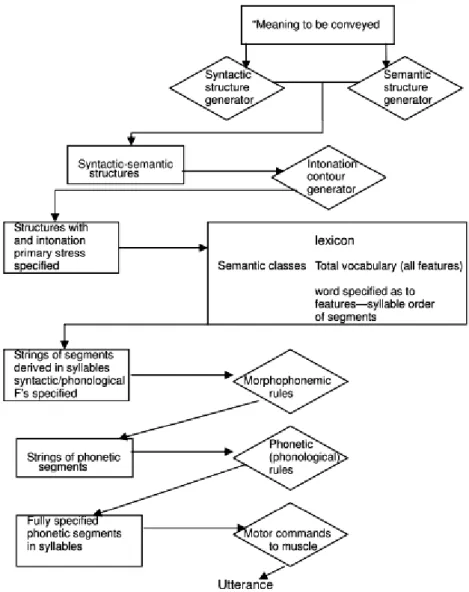
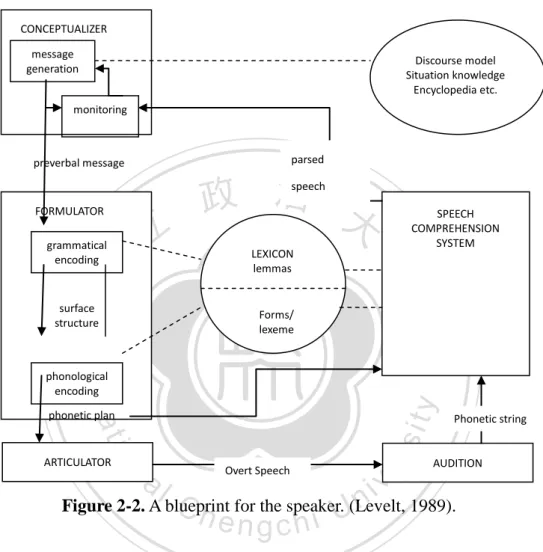
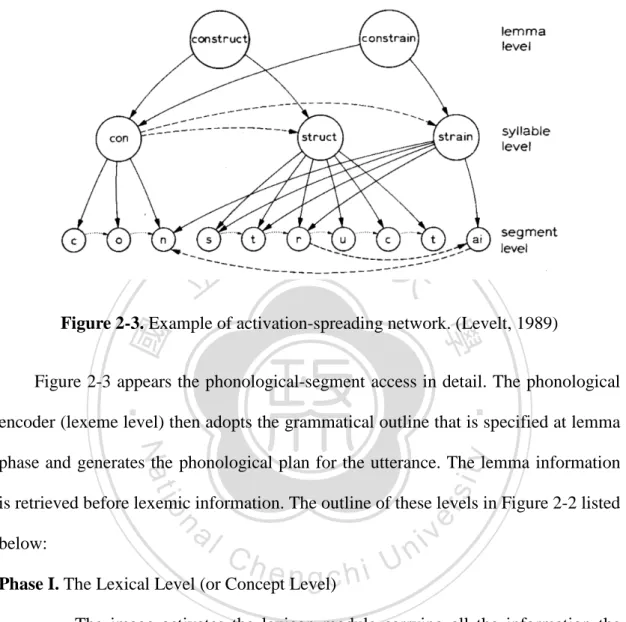
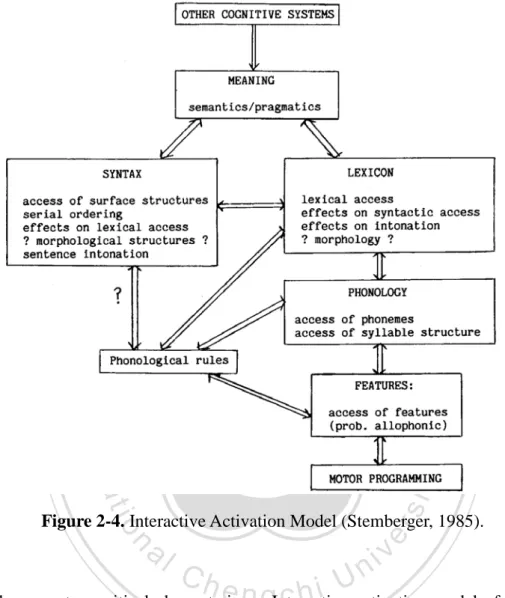
Outline
相關文件
In the second quarter of 2003, the average number of completed units in each building was 11, which was lower than the average value for 2002 (15 units). a The index of
Included in them are 5 056 real estate units amounting to 2.43 billion Patacas, representing variations of -19.8% and -19.7% respectively in number and value over the fourth quarter
In this paper, the author found out the fact that as traditionally Buddhist clerics were exempted from tax paying and national service fulfiling in
6 《中論·觀因緣品》,《佛藏要籍選刊》第 9 冊,上海古籍出版社 1994 年版,第 1
The learning and teaching in the Units of Work provides opportunities for students to work towards the development of the Level I, II and III Reading Skills.. The Units of Work also
Robinson Crusoe is an Englishman from the 1) t_______ of York in the seventeenth century, the youngest son of a merchant of German origin. This trip is financially successful,
fostering independent application of reading strategies Strategy 7: Provide opportunities for students to track, reflect on, and share their learning progress (destination). •
Strategy 3: Offer descriptive feedback during the learning process (enabling strategy). Where the
